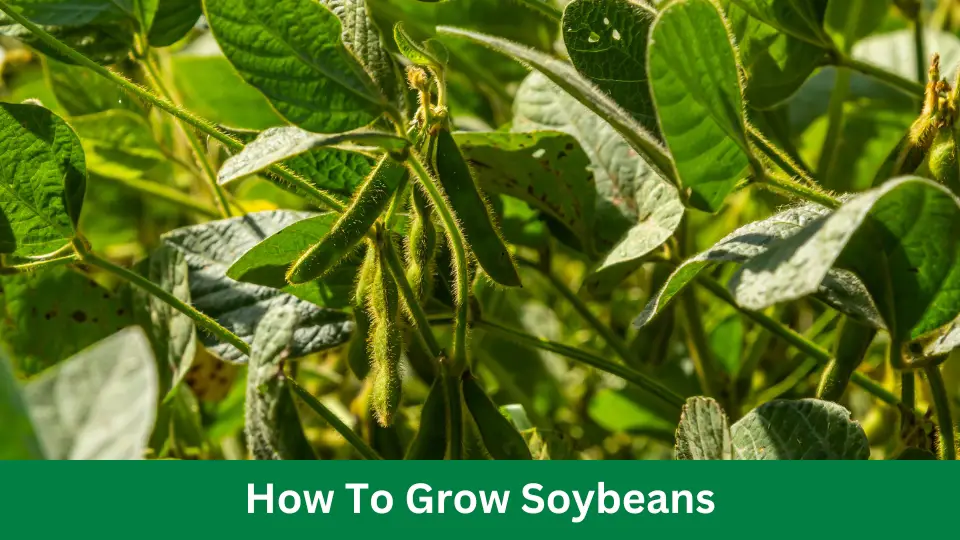To grow soybeans, choose a sunny location with well-drained soil and prepare a fine seedbed. Soybeans, scientifically known as Glycine max, are a versatile legume crop that can be grown in various climates.
Whether you are a farmer or a gardening enthusiast, cultivating soybeans requires proper planning and execution. This guide will explore the step-by-step process of successfully growing soybeans. From selecting the right variety to preparing the soil and sowing the seeds, you will learn all the essential techniques to maximise your soybean yield.
So, let’s dive in and discover how to grow soybeans effectively and achieve a bountiful harvest. Remember, a little knowledge and effort can go a long way in producing healthy, sustainable soybeans.
Selecting The Right Soybean Variety
Choosing the right soybean variety is crucial for a successful soybean crop. By selecting the appropriate variety, farmers can optimise yield and overcome challenges related to climate, soil conditions, disease, and pests.
This article will provide valuable insights into the factors to consider when selecting a soybean variety, including climate, soil conditions, and disease and pest resistance.
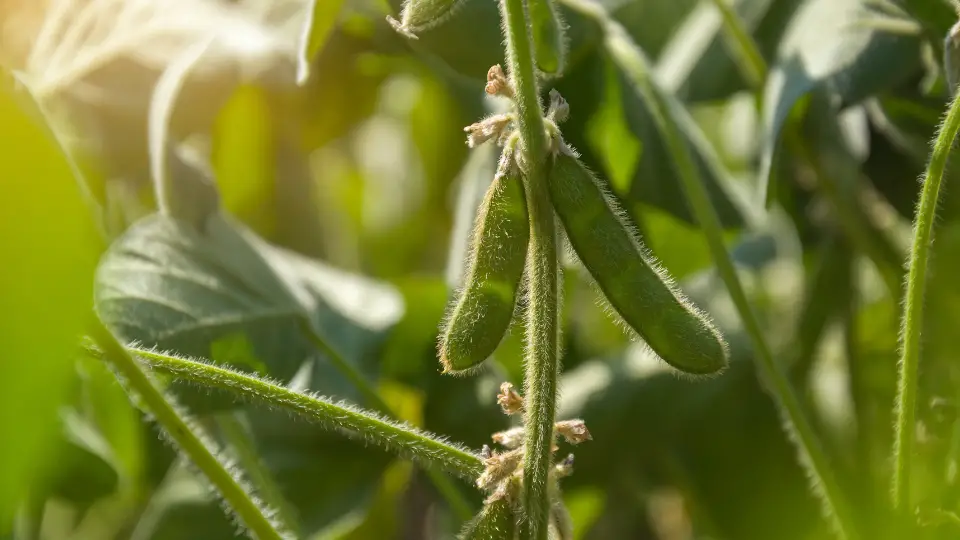
Consider Climate And Soil Conditions
When deciding on the appropriate soybean variety, it is essential to factor in your region’s prevailing climate and soil conditions. Soybeans are known for their adaptability, but they still have specific preferences for optimal growth. Consider the following points:
- Temperature: Soybeans thrive in warm and moderate climates, with an ideal temperature range between 60°F and 85°F. Ensure your chosen variety is suitable for the average temperatures experienced in your area.
- Day length: Soybean varieties are categorised based on their photoperiod sensitivity—the response to different day lengths. Choose a variety that matches the day length in your region to maximise its productivity.
- Moisture: Soybeans require adequate moisture for healthy growth, especially during the reproductive stages. Select a variety that can tolerate the moisture levels in your soil, whether it is well-drained or has a higher water content.
- Soil type: Different soybean varieties exhibit varying adaptability to different soil types. Evaluate your soil’s characteristics, such as texture, fertility, and drainage, ensuring compatibility with the chosen soybean variety.
Evaluate Disease And Pest Resistance
Another crucial aspect to consider when selecting a soybean variety is its resistance to diseases and pests. Farmers can minimise the need for chemical intervention and ensure a healthier crop by choosing a variety with optimal resistance traits.
Here are a few key points to evaluate:
- Disease resistance: Look for soybean varieties known for their resistance to prevalent diseases in your area, such as soybean cyst nematode (SCN), sudden death syndrome (SDS), or white mould. Check with local agricultural experts for guidance on the most common diseases in your region.
- Pest resistance: Consider soybean varieties with built-in resistance against common pests like soybean aphids or bean leaf beetles. This resistance can reduce yield losses and eventually minimise the use of insecticides.
- Herbicide tolerance: Evaluate soybean varieties genetically modified for herbicide tolerance. These varieties can withstand specific herbicides, allowing for more efficient weed control without harming the soybean plants.
By carefully selecting a soybean variety that aligns with your climate, soil conditions, and disease and pest resistance requirements, you can set your crop up for success. Remember to consult local agricultural experts for specific recommendations tailored to your region, ensuring optimal growth and maximum yield.
Preparing The Soil
Growing soybeans starts with preparing the soil, which involves soil testing and analysis and implementing proper soil tillage techniques. These crucial steps ensure your soybean crops have the best foundation for healthy growth and maximum yield.
Soil Testing And Analysis
Before planting soybeans, it is essential to perform a soil test and analysis. Soil testing helps you understand your soil’s condition and nutrient content, allowing you to make informed decisions about fertiliser application.
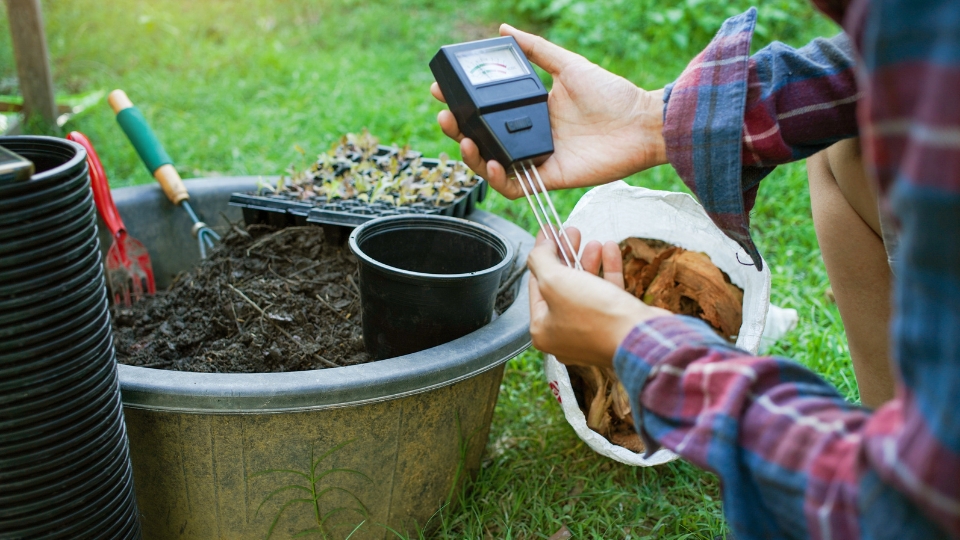
To conduct a soil test, collect samples from different areas of your field and gather separate samples for different soil types or problem areas. The samples should represent the entire field and be taken at the appropriate depth. Consult a local agricultural extension office or a soil testing laboratory to guide you on the proper sampling procedure.
Once you have collected the soil samples, send them for analysis. The soil test will provide valuable information about the soil pH, nutrient levels, and any deficiencies or imbalances. Based on the test results, you can determine the appropriate amounts and types of fertiliser that contribute to optimal soybean growth.
Implementing Proper Soil Tillage
Proper soil tillage is vital for creating an ideal planting bed for soybeans. It helps improve soil structure, control weeds, and enhance water infiltration. Implement the following practices to prepare your soil:
- Begin by removing any crop residue or weeds from the field. Depending on the situation, this can be done using mechanical or chemical methods.
- After that, primary tillage is used to break up the soil and incorporate any necessary amendments or fertilizers indicated by the soil test results.
- Follow primary tillage with secondary tillage, which further refines the soil and helps create a smooth seedbed.
- Ensure the soil is adequately prepared by achieving the right soil moisture content. Too wet or dry soil can hamper proper tillage and impact seed germination.
Proper soil tillage helps establish a favourable environment for soybean root development, improving nutrient uptake and overall plant growth. It is important to note that specific tillage practices may vary based on regional conditions and soil types. Consulting with local agricultural experts and farmers can provide valuable insights tailored to your specific area.
Soybeans Planting Techniques
When it comes to growing soybeans, planting techniques play a crucial role in determining the overall yield and health of the crop. By understanding the optimal planting time, spacing, and depth considerations, farmers can ensure a successful soybean crop.
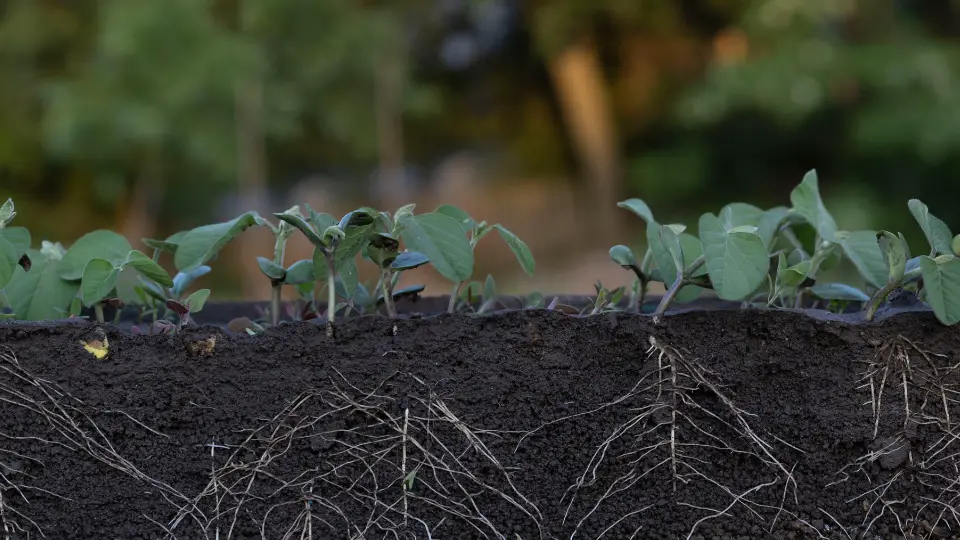
Optimal Planting Time
The optimal time to plant soybeans is in late spring, typically when the soil temperature reaches around 50°F (10°C) at a depth of 2 inches. Planting too early can result in poor germination, while planting too late may lead to reduced yields due to a limited growing season.
Spacing And Depth Considerations
When planting soybeans, spacing and depth are essential factors to be considered.
- For row spacing, aim for around 15–30 inches between rows to allow ample room for the plants to grow and for mechanical equipment to navigate.
- Planting depth for soybeans should generally range from 1 to 1.5 inches.
Nutrient Management
Growing healthy and high-yielding soybean crops requires effective nutrient management. Properly managing the nutrient levels in the soil is essential for promoting vigorous plant growth and maximising yield potential.
In this article, we will explore nutrient management and the key aspects of understanding fertiliser requirements and implementing effective fertilisation practices for soybean cultivation.
Understanding fertiliser Requirements
Before applying fertilisers to your soybean crops, it is crucial to understand their nutrient requirements. Soybeans have specific needs for macronutrients such as nitrogen (N), phosphorus (P), and potassium (K), as well as secondary nutrients like calcium (Ca), magnesium (Mg), and sulphur (S).
Soil testing plays a crucial role in determining the nutrient levels in your soil and guiding fertiliser application decisions. Conducting regular soil tests helps you identify any deficiencies or excesses in essential nutrients, enabling you to tailor your fertilisation approach accordingly. By understanding your soybean field’s specific nutrient profile, you can ensure targeted and efficient fertiliser application.
Additionally, it would be best to consider your soybean plants’ growth stage when calculating the fertiliser requirements. Different growth stages have varying nutrient demands. For instance, young soybean plants require higher phosphorus levels to establish vigorous root systems, while flowering and pod formation stages demand more nitrogen for optimum plant growth and development.
Implementing Effective Fertilisation Practices
Implementing effective fertilisation practices is crucial for maximising nutrient availability for soybean plants while minimising nutrient losses and environmental impact. Here are some key strategies to consider:
- Apply fertiliser immediately. Timing is crucial when fertilising soybean crops. By aligning fertiliser application with key growth stages, you can ensure that nutrients are available when the plants need them the most. Splitting fertiliser applications can also be beneficial, allowing you to meet the crop’s changing nutrient requirements as it progresses through different growth stages.
- Use the right fertilizer types: Different fertilizers have varying nutrient compositions, so it is important to select the right types based on the nutrient deficiencies identified in your soil tests. Nitrogen-based fertilizers, such as urea or ammonium nitrate, are commonly used for replenishing nitrogen levels. Alternatively, phosphorus and potassium can be supplied through fertilizers like monoammonium phosphate (MAP) and potassium chloride (KCl).
- Fertilise based on soil conditions: soil composition and pH levels greatly impact plant nutrient availability. Adjusting soil pH to the optimal range (around 6.0 to 7.0) ensures that essential nutrients are more readily accessible to soybean crops. Incorporating soil amendments like lime or sulphur in highly alkaline or acidic soils can help create more favourable growing conditions.
- Consider nutrient placement: Efficient nutrient placement ensures fertilizer is deposited where the soybean plants can readily absorb it. Depending on the specific nutrient, you can opt for banding, which concentrates fertilizer in a narrower zone, or broadcasting, which spreads it more uniformly across the soil surface. Both approaches have advantages, so carefully evaluate the soil conditions, equipment availability, and specific crop needs.
- Monitor and adjust: Regularly monitoring the nutrient status of your soybean crops throughout the growing season allows you to make timely adjustments to your fertilisation programme. Visual observations, tissue testing, and corrective measures like foliar fertilization can help address nutrient imbalances and optimise plant performance.
Understanding the fertilizer requirements unique to soybeans and implementing effective fertilization practices can enhance nutrient availability, promote healthy plant growth, and increase soybean yield. A targeted and proactive approach to nutrient management is key to achieving optimal results in your soybean farming endeavours.
Pest And Disease Control
Proper pest and disease control is crucial for the successful growth of soybeans. By effectively managing pests and diseases, you can ensure the health and productivity of your soybean crop. In this section, we will discuss how to identify common soybean pests and the implementation of integrated pest management strategies.
Identifying Common Soybean Pests
It is essential to identify common soybean pests to take timely action and prevent significant crop damage. Here are some common soybean pests:
| Pest | Description |
|---|---|
| Aphids | A small, soft-bodied insect that sucks sap from soybean leaves, causing stunted growth and yellowing. |
| Spider Mites | These tiny pests feed on soybean plants, resulting in yellowing leaves, fine webbing, and reduced plant vigour. |
| Corn Earworms | A caterpillar that damages soybean pods, leading to reduced yields and quality. |
Identifying these common pests is the first step in pest control. Regular scouting of fields can help you detect infestations early and take prompt action.
Implementing Integrated Pest Management Strategies
Integrated Pest Management (IPM) effectively controls pests and diseases while minimising the use of chemicals. Here are some strategies to implement IPM for soybean production:
- Crop rotation: Rotate soybeans with other crops to disrupt pest life cycles and reduce pest populations.
- Resistant varieties: Plant soybean varieties that naturally resist pests and diseases in your area.
- Biological control: Encourage beneficial insects like ladybugs and parasitic wasps that feed on soybean pests.
- Monitoring: Regularly monitor fields for pest populations and damage symptoms to determine the need for intervention.
- Cultural practices: Proper irrigation, weed control, and adequate plant nutrition can help minimise pest problems.
- Chemical control: If pest populations exceed the economic threshold, judicious pesticide use can be considered a last resort.
By implementing these integrated pest management strategies, you can effectively control soybean pests while maintaining the health and sustainability of your crop.
Irrigation Strategies
For successful soybean growth, effective irrigation strategies are crucial. Learn the best techniques to ensure optimal water supply and maximise yields.
Irrigation Strategies: Determining Water Needs The first step in implementing effective irrigation strategies for soybean crops is determining their water needs. Understanding the specific hydration requirements of soybeans at different growth stages is essential for optimal yield.
Typically, soybeans need around 1 inch of water per week during the vegetative and reproductive stages. However, this requirement may vary based on weather conditions, soil type, and plant density.
Utilising Efficient Irrigation Methods: Efficient irrigation methods can help conserve water and maximise the effectiveness of irrigation efforts. Drip irrigation and pivot systems are efficient methods that can be used for soybean cultivation. These methods ensure targeted water delivery to the root zone, minimising wastage.
Drip irrigation, particularly, is well-suited for soybeans as it provides a consistent water supply directly to the roots, promoting plant health and reducing water loss through evaporation.
| Irrigation Method | Advantages | Disadvantages |
| Drip irrigation | Conserves water, ensures precise water delivery to roots, and reduces weed growth. | Initial installation cost may be high, and maintenance and monitoring required |
| Pivot systems | Efficient water distribution, suitable for large fields, and reduced labour costs | High initial investment, mechanical maintenance required |
Weed Management
To effectively grow soybeans, it is crucial to employ proper weed management strategies. This involves regular monitoring of the field, timely removal of weeds, and implementing preventive measures to minimise weed competition. Farmers can ensure optimum soybean growth and yield by integrating effective weed control measures.
Identifying Common Soybean Weeds
Identifying common soybean weeds is essential for effective weed management. By understanding the characteristics of these weeds, farmers can tailor their weed control plans accordingly. Here are some common soybean weeds you may encounter in your fields:
| Weed | Description | Control Measures |
|---|---|---|
| Palmer Amaranth | Fast-growing and invasive weed with tall, spiky stems. | Herbicide-resistant varieties are available. Regular monitoring and timely removal are necessary. |
| Waterhemp | Similar in appearance to Palmer Amaranth but can grow up to 6 feet tall. | Pre-emergence herbicides and crop rotation can help control water. |
| Giant Ragweed | Large, broadleaf weed that can grow up to 15 feet tall. | Timely herbicide applications and crop rotation strategies can manage giant ragweed. |
Developing Weed Control Plans
Developing a weed control plan ensures healthy soybean growth and maximises yield potential. Here are some key steps to consider when developing your weed control plan:
- Assess your field: Conduct a thorough assessment of your field to identify weed species and determine their prevalence.
- Choose the right herbicides: Select herbicides that effectively target the identified weed species and are safe to use on soybeans.
- Utilise multiple strategies: Implement a combination of cultural practices, such as crop rotation, cover cropping, and herbicide applications, to manage weeds effectively.
- Timing is crucial. Apply herbicides at the appropriate time, considering the growth stage of both the soybeans and the weeds.
- Monitor and adapt: Regularly monitor your fields for weed growth and evaluate the effectiveness of your weed control measures. Make adjustments if necessary to prevent weed resistance.
- Follow label instructions: Always follow the label instructions of the herbicides you use to ensure proper application and minimise the risk of crop damage.
By identifying common soybean weeds and developing a comprehensive weed control plan, farmers can effectively manage weeds and promote the healthy growth of their soybean crops.
Growing Soybeans: Monitoring Growth And Development
Monitoring the growth and development of soybeans is crucial to ensuring a successful harvest. By regularly assessing their progress, you can identify any potential issues early on and take the necessary steps to address them.
This section will discuss the two key aspects of monitoring soybean growth and development: utilising growth stage monitoring and assessing overall plant health.
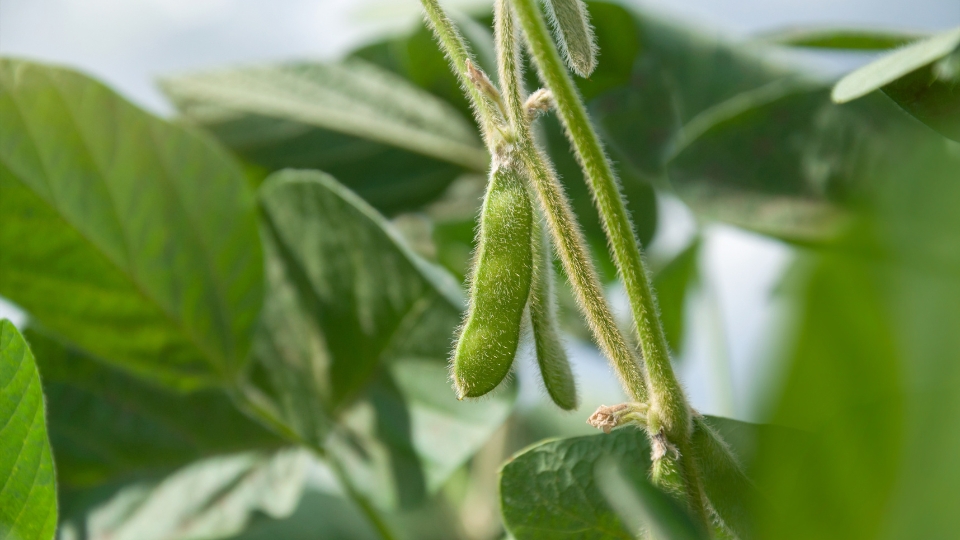
Utilising Growth Stage Monitoring
Soybeans go through distinct growth stages, and monitoring them allows you to make informed decisions about various aspects of their care. Here’s a breakdown of the different growth stages:
| Stage | Description |
|---|---|
| Vegetative Stage | The plant’s focus is on leaf and stem development. |
| Reproductive Stage | Flowering and pod development occur. |
| Pod-Filling Stage | The seeds inside the pods develop and fill out. |
| Ripening Stage | The pods turn from green to yellow or brown as the soybeans mature. |
By monitoring these growth stages, you can determine the optimal time for fertilising, irrigating, or applying pesticides. For example, during the reproductive stage, when the plant focuses on flowering and pod development, providing adequate water and nutrients is crucial for a robust yield.
Assessing Overall Plant Health
To ensure the overall health of your soybean plants, it’s vital to monitor them for any signs of nutrient deficiencies, diseases, or pests. Regularly inspect the plants for the following indicators of plant health:
- Leaf colour: Healthy soybean leaves should be bright green. Yellowing or browning may indicate nutrient deficiencies or disease.
- Foliage density: A dense canopy signifies strong plant growth. Sparse foliage may be a sign of stress or inadequate nutrition.
- Leaf abnormalities: Look for signs of spots, lesions, or other irregularities on the leaves, indicating diseases such as leaf spots or rust.
- Pest presence: Watch for pests like aphids, Japanese beetles, or spider mites that can damage the plant.
If you notice any issues during your assessments, take prompt action to mitigate the problem. This may involve applying appropriate fertilisers, administering disease control measures, or implementing pest management strategies.
Monitoring the growth and development of soybeans by utilising growth stage monitoring and assessing overall plant health is vital for a successful harvest. By staying attentive to their progress and promptly addressing any issues that arise, you can optimise the yield of your soybean crop.
Harvesting Techniques
Harvesting soybeans at the right time and with proper techniques ensures a successful crop yield. Knowing the optimal time to harvest, utilising the correct equipment, and following best practices are essential steps in harvesting.
Optimal Harvest Time
The ideal time for harvesting soybeans is when they have reached physiological maturity. Full-size pods, yellowing leaves, and ripe seeds indicate this stage. Soybeans are typically harvested when the moisture content reaches around 13–15%. It’s important to monitor the moisture levels to avoid harvesting too early or too late.
Utilising Proper Harvesting Equipment
Using the right equipment ensures efficiency and minimises damage to the crop. Combines equipped with flex or draper headers are commonly used for soybean harvesting.
These headers allow for smooth cutting and feeding of the soybean plants while reducing shattering, which can cause yield loss. It’s also crucial to maintain and properly adjust the combine to prevent pod shattering and seed loss during harvesting.
Post-harvest Considerations
Growing soybeans is just the first step in cultivating this versatile crop. Once the soybean plants have been harvested, there are several important post-harvest considerations that need to be taken into account to ensure the quality and marketability of the beans.
These considerations include drying and storage practices, quality assessment and marketing strategies.
Drying And Storage Practices
Proper drying and storage practices are crucial in maintaining the quality of soybeans after harvest. The moisture content of freshly harvested soybeans must be reduced to prevent spoilage and the growth of moulds and fungi.
This can be achieved using effective drying techniques such as air drying, fans and blowers, or specialised drying equipment.
In addition to drying, appropriate storage conditions are essential to prevent moisture reabsorption and protect the beans from pests and diseases. Storing soybeans in clean, well-ventilated containers or silos can help maintain their quality over an extended period. It is also important to regularly monitor storage conditions and inspect the beans for any signs of spoilage.
Quality Assessment And Marketing
To verify soybean quality meets standards, test them before marketing. Moisture, foreign material, and appearance are assessed. Moisture metres and sieves can measure moisture and eliminate contaminants in simple quality testing.
After quality assessment, soybean marketing strategies can be created. This may involve networking with local marketplaces, wholesalers, grain buyers, or exporting. Farmers may maximise income and discover the best soybean markets by building a strong buyer network and following market trends.
In conclusion, soybean production performance depends on post-harvest considerations. Proper drying and storing help preserve bean quality, while quality assessments and marketing methods can boost profits.
By following these post-harvest processes, soybean producers may ensure high-quality beans and market success.
Frequently Asked Questions About How To Grow Soybeans
Are Soybeans Easy To Grow?
Yes, soybeans are easy to grow. They require full sun, well-drained soil, and regular watering.
How Long Does It Take To Grow Soybeans?
It takes approximately 90 to 120 days for soybeans to grow from planting to harvest.
How Many Soybeans Does One Plant Produce?
A soybean plant produces around 50 pods, each containing 2–3 beans on average. Therefore, one plant typically yields around 100–150 soybeans.
Decision
Growing soybeans can be a rewarding experience. You can ensure a successful harvest by following the right techniques and understanding the crop’s needs. Monitor soil moisture, manage pests, and provide adequate nutrition to optimise soybean growth.
With dedication and knowledge, you can cultivate a thriving soybean crop on your farm.
This Info Article Video Source: https://www.youtube.com/watch?v=dhTTXwFiH1A

